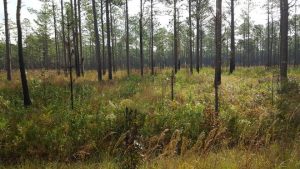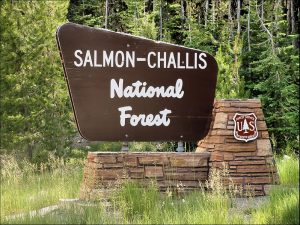Sharon referred to “where fire suppression is a fact of life.” I referred to the planning question of identifying where those areas are. It seems to me that would be either where fires won’t ever occur (hard to imagine), or where they can’t be allowed to burn. The reason in the latter case would depend on some kind of values at risk. I continue to be amazed at how unwilling the Forest Service is to attack this problem from that direction – minimizing the values at risk in areas that are likely to burn. In particular, their engagement (or lack thereof) with local community planning for developments and infrastructure. And there are other reasons besides fire risk, in particular fragmentation of wildlife habitat that reduces connectivity.
Any way, here is an example from the Croatan National Forest.
The 2002 Croatan National Forest Land and Resource Management Plan stated that around 70 percent of the Croatan is home to short interval fire-adapted ecosystems—like pine trees and pocosins.
Low-intensity, prescribed fires allows nutrient cycling to occur. Without them, the entire structure and composition of species are subject to change.
“These are fire-maintained habitats, without prescribed burnings, it is like trying to save a salt marsh without the tide,” said Fussell.
Longleaf pine restoration is especially dependent on prescribed fires as the exposed soil helps the seeds to germinate and they control the population of competing pine variations.
Prescribed burning is harder to do the more fragmented an ecosystem is and the closer it gets to development. Because it is harder to burn in smaller areas, prescribed burnings have decreased in recent years, said Fussell.
The Forest Service has a legal imperative to NOT allow the structure and composition of species to change. Where adjacent development has already occurred, fire suppression is probably going to be a “fact of life,” but that fact should be motivating the Forest Service to participate in local planning to encourage future development consistent with the fire regime on the adjacent national forest. It’s difficult to understand why no one from the Forest Service was interviewed for this article, since they should be on the forefront of these kinds of discussions. (They evidently did get involved in some highway planning in order to continue prescribed burning, which at least suggests they recognize the problem.)
This article cites some research that reiterates the findings of the Forest Service “Forest on the Edge” program (which I contributed to along the way).
By 2030, a study from 2009 by researchers at the University of Wisconsin and other industry professionals, projects that 16 million new housing units will be built around national forests across the United States. A projected 662,000 will be built in national forests.
“New houses will remove and fragment habitats, diminish water quality, foster the spread of invasive species and decrease biodiversity,” stated the study.
This is happening everywhere, and the Forest Service needs to be more assertive in trying to minimize the areas “where fire suppression is a fact of life.”




